Lately I’ve been doing statistical analysis on D&D 5e monsters to see how they’re built, and I’ve learned some interesting things: the DMG monster-creation guidelines don’t work as expected, monster design formulae have stayed stable from book to book, and many of the complexities of the official monster-design process don’t significantly affect its outcome.
Today, let’s come up with simple instructions for creating monsters in line with the Monster Manual, replacing the faulty instructions in the DMG.
Along the way, I think we can streamline the process. The Dungeon Master’s Guide has 9 pages on monster creation. I think we can fit the key rules on one page. Or even a business card. That way, you can create new monsters on the fly, not as a laborious game prep chore.
First of all, to reiterate what I learned in previous posts:
1) real monsters have fewer hit points and do less damage than those created by the DMG chart, and are more accurate
2) there is no significant correlation between any major monster stat (HP, AC, attack bonus) and any other stat. For instance, you might expect that a monster whose AC is high for its Challenge Rating should have lower hit points, attack bonus, or damage output to compensate. That’s not the case. Therefore, we can examine each monster stat separately without having to consider the others at the same time.
attack bonus
Here’s a scatter plot of the attack bonuses of all the Monster Manual and Mordenkainen’s monsters. The black line is the best fit line. (For comparison, the red line is a plot of the Dungeon Master’s Guide suggested attack bonuses.)
As you can see, the scatter plot shows us a nice, straight, easily graphable best-fit line. It works out to almost exactly:
So tidy! It’s almost as if the designers designed it that way! Hint: I think they did. While the DMG graph is arbitrary and inaccurate, actual monster design shows signs of being very carefully put together.
A note about CRs below 1: These complicate things. For the purposes of drawing graphs, think of them as negative numbers instead of fractions: CR 1/2 is really 0, CR 1/4 is -1, CR 1/8 is -2, CR 0 is -3. That’s the way that the linear values on the attack graph work out, and the way I’ve graphed it.
How much leeway do we have to adjust the attack bonus up or down based on our concept? The DMG advice is to adjust as much as you want, you can always adjust the CR later. We don’t want to adjust anything later! We’ll just look at our Monster Manual data and see how much variation there tends to be from the average monster accuracy.
For our attack bonuses, the average variance (which is a statistical calculation for determining how closely grouped numbers are) is low: 1.22. In other words, monster attack bonuses tend to be a little more than one point away from the average. And, as we’ve proved in previous steps, there is no correlation between high/low attack bonus and any other monster stat. So we could say, without doing too much violence to the Monster Manual data, something like, “Based on your monster concept, you may add or subtract up to 2 points from the attack bonus without affecting its CR.”
DC
Difficulty Class is similarly neat. In fact, its graph is nearly identical to the attack bonus (nearly every monster’s DC is their attack +7). In the following scatter plot, blue X’es are DC, and green triangles are attack bonus.
The DC best-fit formula is
Variance is also the same for DC as it is for attack bonus. So on our final rules, we’ll say, “+-2 DC based on monster concept.”
Armor Class
From the scatter plot, Armor Class also looks like a fairly neat linear graph.
Expressed as a formula, this is very tidy: AC = 13 + 1/3 CR
From looking at the scatter plot, you can see that there will be a higher variance in AC than there was in attack and DC. The average variance is 1.65: 50% more than in attack and DC. Therefore, if we say “+-3 AC based on monster concept” we’d be allowing all but a few outliers.
hit points and damage
I did attack bonus, DC, and AC first because they were the easy ones. The remaining values, average damage and hit points, are a bit hairy, because they’re not nice, neat linear graphs.
Here’s one interesting thing about hit points and damage: they have a very strong relationship, especially at low level. Take a look at this chart where I graph median hit points (blue) and median damage x 3 (red).
To me it kind of looks like the average monster’s hit points is intended to be 3x the average monster’s damage (or, to put it another way, each monster should survive exactly three rounds of hits against one of its peers). Given the fact that the D&D designers have frequently mentioned three rounds as their target combat length, this seems plausible.
I admit, something about the chart above gave me pause. At high CR, doesn’t it look like there is an inverse correlation between damage and hit points? At CR 19 and 21, for instance, where damage is high, hit points are low. Did I miss something in my earlier analysis that showed no such correlation?
After looking at this graph, I did a more thorough statistical analysis. A note about my methodology: I calculated p-value for each pair of stats (above-median damage AC vs below-median HP, etc) and also for each stat paired with the presence of major special defenses, major special attacks, and legendary status. No correlation was significant to a value of p = .05. However, some more confident statistician should re-check my values with the Monster Manual dataset, since I’m not really a stats guy, just a guy with access to free web stats tools.
In particular, the seeming correlation we see on this chart, high damage to low hit points, does exist but is statistically insignificant: in the monster population as a whole, of the 227 monsters who deal higher-than-median damage, 101 have under-median hit points and 96 have above-median HP: a difference of 5 monsters either way. But some of the similar monsters happen to be clumped together. For instance, it just so happens that three low-HP, high-damage monsters are grouped together at that big red spike at level 18. I think we just have to say that, at high levels, our data is sparse and unreliable and we are going to have to be careful not to over-model the ups and downs of the graph.
At low levels, though, where we have dozens of monsters per CR (and where D&D play actually happens), I do want to be as faithful to the data as I can.
Take another look at the graph above and then listen to my crazy plan. Hit points and damage x 3 look pretty damn correlated: The correlation may or may not be intentional, but it’s there. Maybe we can come up with one trend line that will describe both hit points and damage?
Here’s that graph again, with my proposed best-fit threading the needle between the hit points and damage line. The data isn’t linear at low CRs, but high CRs are linear enough.
Here are the formulae for average damage and hit points:
Average damage below CR 1: 1, 3, 5, 8
Average damage between CR 1 and 7: 5 + (CR x 5)
Average damage above CR 7: CR x 5
Average hit points: 3x average damage for that CR
Unlike for AC, DC and CR, variance increases quite a bit for hit points and damage as the numbers get bigger. Take a look at this damage scatter plot, which sort of explodes into confetti once we get to the airy heights of CR 10.
For both hit points and damage, we can say Increase or decrease by up to 50% based on monster concept and get all but a few outliers.
Shouldn’t such a big increase or decrease – for instance, bumping a monster from 100 to 50 or 150 HP, or from 30 damage to 15 or 45 damage – change its CR? Perhaps it should, but it doesn’t in the corpus. There are plenty of examples of monsters with wildly varying hit points and damage potential sitting next to each other in the same Challenge Rating – without any other attributes which obviously compensate for the differences. Consider Geryon and the ancient green dragon, both CR 22.
Geryon: AC 19, HP 300, attack +16, damage per round 97
Ancient green dragon: AC 23 (+4), HP 385 (28% higher), attack +15 (-1), damage per round 151 (55% higher)
It’s wacky, but it’s how CR currently works. And I’m trying to describe CR here, not improve on it.
We need to do one other thing before we leave the topic of damage: on our new, improved monster-creation rules, we have to explain our average damage calculations so that people can turn each monster’s raw damage total into arbitrarily complex sets of attacks, including spells, area attacks, and limited-use abilities. This will be hard to explain concisely and clearly, but let’s take a shot at it.
Here’s a first draft: “Damage: This is the average damage that a monster can do each round during the first three rounds of combat. Assume 1) it always uses its most damaging attack(s) or spell which hasn’t yet been exhausted; 2) all area attacks target 2 enemies; 3) auras and similar traits target one enemy per turn; 4) variable-length effects like Swallow last one turn; 5) all attacks hit; 6) all opponents fail saving throws. Based on the monster concept, the monster’s damage may be dealt in one attack, or be divided between multiple attacks and/or legendary actions.”
This encapsulates the rules as described in the DMG. There’s one problem with these rules though. They’re facing the wrong way. They’re the instructions to take a Monster Manual creature and turn it into a single damage number. We need the instructions to take a single damage number and turn it into a Monster Manual creature. How about this:
Damage: This is the damage budget for all the monster’s attacks. Limited-use (daily, recharge, or situational) attacks do 4x the damage budgeted. Multi-target attacks do ½ the damage budgeted. Limited-use multi-target attacks do 2x. All other damage sources are 1 for 1, including at-will and legendary single-target attacks, auras, reactions, and variable-length effects like Swallow. If a monster has several at-will options (such as melee and ranged), the lower-damage options are free.
Here’s an example of how you could spend a damage budget on several attacks. Let’s say you imagine a fire-using spellcaster. You give her a 1/day fireball for 28 damage (spending 14 points of the damage budget); an at-will Fire Blast against one target that does 11 damage (spending 11 damage); and, to round it out, a 3-damage dagger attack (free because it’s an at-will option that does less damage). That would cost us 25 damage: right on the nose for a CR 4 creature. But because of the variance in damage, she could be pegged as anything between a strong CR 2 (on par with a pentadrone) and a very weak CR 10 (on par with a CR13 rakshasa).
monster traits
Nearly every monster, except for beasts and some boring humanoids, have some “schtick:” some special trait that makes them unique. It’s hard to quantify these. The DMG tries: it offers two pages of traits, listing the modification that should be made for each to the effective HP or AC. Most of these minor modifications, by the DMG rules, are worth a fraction of a CR. Given the wild fluctuations in power of same-CR creatures, this is illusory precision (I talk more about that here).
We can test common and seemingly powerful traits like legendary resistance and magic resistance and in almost all cases, the presence or absence of these traits has no correlation to higher or lower monster statistics. Therefore, they are not visibly affecting a monster’s CR. The only verifiable exceptions, as I mentioned here, are regeneration (which has a negligible but real effect, reducing some monster HP a by a few percent) and possession (which has a large effect, halving hit points) and possibly damage transfer. I think we can turn these three cases into a general rule: you may reduce damage-avoiding monsters’ hit points by the amount of damage you expect them to avoid over 3 rounds of combat.
what about saving throws?
I think we can improve on the original DM’s Guide rules in another way. The DMG chart has values for proficiency bonus, AC, HP, attack, damage and save DC. Monsters also need to make saving throws. Really, what we want to know is, “what does a saving throw look like for a monster’s good stat?” and “what does a saving throw look like for a monster’s bad stat?”
The bad saving throw is easy. It can be anything based on the monster’s story! For instance, the tarraque’s Dex save is +0.
For the good saving throws: calculating this was an afterthought and I didn’t feel like manually entering the good saving throws for the entire Monster Manual. I decided to see if a sample would be enough. I manually entered the best saving throws of all of the monsters up to page 84 of the Monster Manual, right before the start of the Dragons entry. I also added the ancient red dragon, so I could get the good saving throw of the strongest non-thought-experiment monster in the game. Based on how the data looked, I’d see if I had enough information or if I needed more. Here’s what I got.
This data is clearly tightly-grouped and linear: I don’t need any more sample to see that. It’s a hair off of 1 point of saving throw bonus per 2 levels. This formula will always keep us within about half a point of the real value:
3 + 1/2 CR
And the eye test tells me that variance is very low. I’d estimate it at +- 2. That is to say: the saving throw bonus column is equal to the Attack Bonus column minus 1.
By the way, 3 + 1/2 CR also works for a monster’s good skills!
OK, now we have everything we need to make a complete chart replacing the one in the Dungeon Masters Guide! This will give us out-of-the-box numbers that closely match the Platonic ideal of a 5e monster of any CR. Just tweak according to taste, add a special ability or two, and you are good to go. This is something you can do live at the table, not as part of your game prep!
Here’s the finished chart:
And here’s a PDF that you can print out and put in your DMG.
And if you want something really compact, here’s the important rules on a business card:
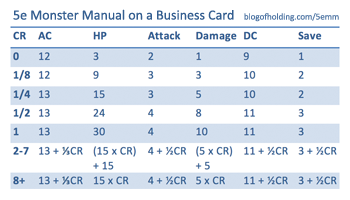
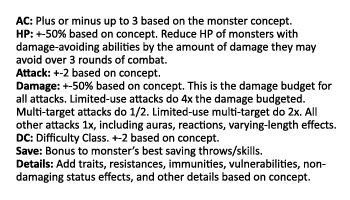
Next up in the monster math series: Monsters of the Multiverse Math!

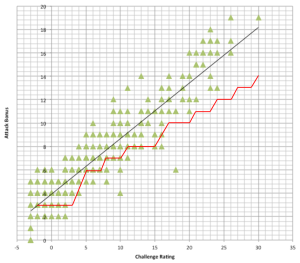
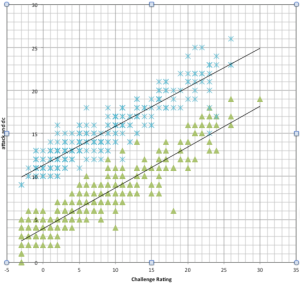
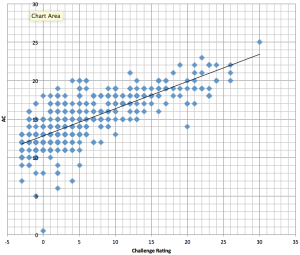
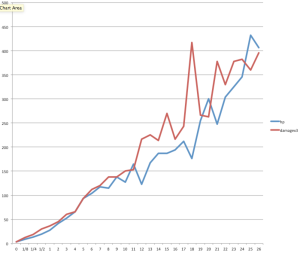
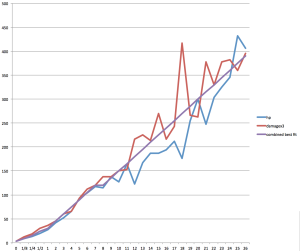
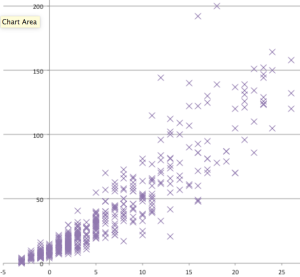
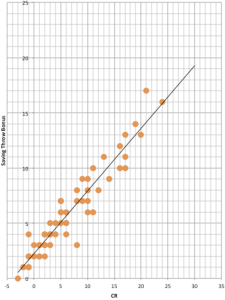








“You give her a 1/day fireball for 28 damage (spending 14 points of the damage budget)”
I thought daily attacks do “4x the damage budgeted”?
Oh, wait, nevermind, multi-target, sorry.
Excellent! I got a lot of use out of the original MM3 on a business card for 4E, so I’ve been looking forward to something like this for 5E. Gonna be testing this out live at he table next month. Thanks for doing the legwork in analyzing the data and putting it all together!
Any chance of a pdf version of the card-sized one? It doesn’t print too crisp as an image. Just put the sides next to each other and we can fold it in half to put part on the back.
The AC graph looks heteroscedastic: variance in AC is greater for lower challenge ratings than for higher challenge ratings. A robust estimator might give a slightly different slope.
That nit picked, this post is an *amazing* bit of reverse engineering of some of the design principles behind 5e! Kudos!
So, I turned those values/ranges into dice formulas. (I had to use hypothetical dice to make the math work, use a dice rolling app/website (like anydice)). CSV ahoy!
CR,AC,HP,Attack,Damage,DC,Save
0,2d4+7 (12),3d2-1 (3),2d3-2 (2),2d2-2 (1),2d3+5 (9),2d3-3 (1)
1/8,2d4+7 (12),3d4+0 (9),2d3-1 (3),3d2-1 (3),2d3+6 (10),2d3-2 (2)
1/4,2d4+8 (13),4d7+1 (15),2d3-1 (3),3d3+0 (5),2d3+6 (10),2d3-2 (2)
1/2,2d4+8 (13),4d11+2 (24),2d3+0 (4),3d4+0 (8),2d3+7 (11),2d3-1 (3)
1,2d4+8 (13),3d14+4 (30),2d3+0 (4),3d5+1 (10),2d3+7 (11),2d3-1 (3)
2,2d4+8 (13),4d20+5 (45),2d3+1 (5),4d7+1 (15),2d3+8 (12),2d3+0 (4)
3,2d4+9 (14),4d26+6 (60),2d3+1 (5),4d9+1 (20),2d3+8 (12),2d3+0 (4)
4,2d4+9 (14),4d33+9 (75),2d3+2 (6),4d11+2 (25),2d3+9 (13),2d3+1 (5)
5,2d4+9 (14),4d39+10 (90),2d3+2 (6),3d14+4 (30),2d3+9 (13),2d3+1 (5)
6,2d4+10 (15),4d46+13 (105),2d3+3 (7),4d16+4 (35),2d3+10 (14),2d3+2 (6)
7,2d4+10 (15),4d52+14 (120),2d3+3 (7),4d18+5 (40),2d3+10 (14),2d3+2 (6)
8,2d4+10 (15),4d52+14 (120),2d3+4 (8),4d18+5 (40),2d3+11 (15),2d3+3 (7)
9,2d4+11 (16),4d59+17 (135),2d3+4 (8),4d20+5 (45),2d3+11 (15),2d3+3 (7)
10,2d4+11 (16),4d65+18 (150),2d3+5 (9),4d22+5 (50),2d3+12 (16),2d3+4 (8)
11,2d4+11 (16),4d72+21 (165),2d3+5 (9),4d24+6 (55),2d3+12 (16),2d3+4 (8)
12,2d4+12 (17),4d78+22 (180),2d3+6 (10),4d26+6 (60),2d3+13 (17),2d3+5 (9)
13,2d4+12 (17),4d85+25 (195),2d3+6 (10),4d29+8 (65),2d3+13 (17),2d3+5 (9)
14,2d4+12 (17),4d91+26 (210),2d3+7 (11),4d31+9 (70),2d3+14 (18),2d3+6 (10)
15,2d4+13 (18),4d98+29 (225),2d3+7 (11),4d33+9 (75),2d3+14 (18),2d3+6 (10)
16,2d4+13 (18),4d104+30 (240),2d3+8 (12),4d35+9 (80),2d3+15 (19),2d3+7 (11)
17,2d4+13 (18),4d111+33 (255),2d3+8 (12),4d37+10 (85),2d3+15 (19),2d3+7 (11)
18,2d4+14 (19),4d117+34 (270),2d3+9 (13),4d39+10 (90),2d3+16 (20),2d3+8 (12)
19,2d4+14 (19),4d124+37 (285),2d3+9 (13),4d42+12 (95),2d3+16 (20),2d3+8 (12)
20,2d4+14 (19),4d130+38 (300),2d3+10 (14),4d44+13 (100),2d3+17 (21),2d3+9 (13)
21,2d4+15 (20),4d137+41 (315),2d3+10 (14),4d46+13 (105),2d3+17 (21),2d3+9 (13)
22,2d4+15 (20),4d143+42 (330),2d3+11 (15),4d48+13 (110),2d3+18 (22),2d3+10 (14)
23,2d4+15 (20),4d150+45 (345),2d3+11 (15),4d50+14 (115),2d3+18 (22),2d3+10 (14)
24,2d4+16 (21),4d156+46 (360),2d3+12 (16),4d52+14 (120),2d3+19 (23),2d3+11 (15)
25,2d4+16 (21),4d163+49 (375),2d3+12 (16),4d55+16 (125),2d3+19 (23),2d3+11 (15)
26,2d4+16 (21),4d169+50 (390),2d3+13 (17),4d57+17 (130),2d3+20 (24),2d3+12 (16)
Ignore my last comment, this is better:
CR,AC,HP,Attack,Damage,DC,Save
0,2d4+7 (12),2d2+0 (3),2d3+-2 (2),2d2-2 (1),2d3+5 (9),2d3+-3 (1)
1/8,2d4+7 (12),3d4+1 (9),2d3+-1 (3),2d2+0 (3),2d3+6 (10),2d3+-2 (2)
1/4,2d4+8 (13),3d6+4 (15),2d3+-1 (3),3d3-1 (5),2d3+6 (10),2d3+-2 (2)
1/2,2d4+8 (13),4d7+8 (24),2d3+0 (4),4d3+0 (8),2d3+7 (11),2d3+-1 (3)
1,2d4+8 (13),4d9+10 (30),2d3+0 (4),4d4+0 (10),2d3+7 (11),2d3+-1 (3)
2,2d4+8 (13),3d16+19 (45),2d3+1 (5),3d5+6 (15),2d3+8 (12),2d3+0 (4)
3,2d4+9 (14),4d18+25 (60),2d3+1 (5),4d6+7 (20),2d3+8 (12),2d3+0 (4)
4,2d4+9 (14),4d22+30 (75),2d3+2 (6),3d8+10 (25),2d3+9 (13),2d3+1 (5)
5,2d4+9 (14),4d26+36 (90),2d3+2 (6),4d9+11 (30),2d3+9 (13),2d3+1 (5)
6,2d4+10 (15),4d31+44 (105),2d3+3 (7),3d11+15 (35),2d3+10 (14),2d3+2 (6)
7,2d4+10 (15),4d35+49 (120),2d3+3 (7),4d12+16 (40),2d3+10 (14),2d3+2 (6)
8,2d4+10 (15),4d35+49 (120),2d3+4 (8),4d12+16 (40),2d3+11 (15),2d3+3 (7)
9,2d4+11 (16),4d39+55 (135),2d3+4 (8),3d14+19 (45),2d3+11 (15),2d3+3 (7)
10,2d4+11 (16),4d44+63 (150),2d3+5 (9),4d15+20 (50),2d3+12 (16),2d3+4 (8)
11,2d4+11 (16),4d48+68 (165),2d3+5 (9),4d16+21 (55),2d3+12 (16),2d3+4 (8)
12,2d4+12 (17),4d52+74 (180),2d3+6 (10),4d18+25 (60),2d3+13 (17),2d3+5 (9)
13,2d4+12 (17),4d57+82 (195),2d3+6 (10),4d19+26 (65),2d3+13 (17),2d3+5 (9)
14,2d4+12 (17),4d61+88 (210),2d3+7 (11),4d21+29 (70),2d3+14 (18),2d3+6 (10)
15,2d4+13 (18),4d65+93 (225),2d3+7 (11),4d22+30 (75),2d3+14 (18),2d3+6 (10)
16,2d4+13 (18),4d70+101 (240),2d3+8 (12),4d24+34 (80),2d3+15 (19),2d3+7 (11)
17,2d4+13 (18),4d74+107 (255),2d3+8 (12),4d25+35 (85),2d3+15 (19),2d3+7 (11)
18,2d4+14 (19),4d78+112 (270),2d3+9 (13),4d26+36 (90),2d3+16 (20),2d3+8 (12)
19,2d4+14 (19),4d83+120 (285),2d3+9 (13),4d28+39 (95),2d3+16 (20),2d3+8 (12)
20,2d4+14 (19),4d87+126 (300),2d3+10 (14),4d29+40 (100),2d3+17 (21),2d3+9 (13)
21,2d4+15 (20),4d91+131 (315),2d3+10 (14),4d31+44 (105),2d3+17 (21),2d3+9 (13)
22,2d4+15 (20),4d96+139 (330),2d3+11 (15),4d32+45 (110),2d3+18 (22),2d3+10 (14)
23,2d4+15 (20),4d100+145 (345),2d3+11 (15),4d34+48 (115),2d3+18 (22),2d3+10 (14)
24,2d4+16 (21),4d104+150 (360),2d3+12 (16),4d35+49 (120),2d3+19 (23),2d3+11 (15)
25,2d4+16 (21),4d109+158 (375),2d3+12 (16),4d37+53 (125),2d3+19 (23),2d3+11 (15)
26,2d4+16 (21),4d113+164 (390),2d3+13 (17),4d38+54 (130),2d3+20 (24),2d3+12 (16)
27,2d4+17 (22),4d117+169 (405),2d3+13 (17),4d39+55 (135),2d3+20 (24),2d3+12 (16)
28,2d4+17 (22),4d122+177 (420),2d3+14 (18),4d41+58 (140),2d3+21 (25),2d3+13 (17)
29,2d4+17 (22),4d126+183 (435),2d3+14 (18),4d42+60 (145),2d3+21 (25),2d3+13 (17)
30,2d4+18 (23),4d130+188 (450),2d3+15 (19),4d44+63 (150),2d3+22 (26),2d3+14 (18)
Fantastic work! I second Mark’s request for a PDF of the business card, if it’s not too much trouble.
Very appreciated. I’m going to get a lot of mileage out of this.
I thought the same about the heteroscedasticity of the AC set, but also agree that the slope change would be slight and the effect on these guidelines would be pretty minimal. In other words, I wouldn’t think it would be worth the work to do use a different model for it as I don’t think there’d be a useful for game play change in the average variance at low levels. But mostly, I’m just posting this because I wanted to use the word heteroscedasticity in a sentence again. It’s been years.
Hey, I made a PDF for the business card-sized rules. Not sure if I’m allowed to link it here for download, but if it’s ok, I’d share the PDFs.
This is incredible and so much better than the DMG-outlined items! I’m going to create some kind of personal monster creator from this and add the attribute/attack layers on-top.
If anyone is thinking about home brewing some tooling around this idea, here’s the full chart in JSON format, keyed by CR.
{
“0”: {
“AC”: 12,
“HP”: 3,
“Attack”: 2,
“Damage”: 1,
“DC”: 9,
“Save”: 1
},
“1”: {
“AC”: 13,
“HP”: 30,
“Attack”: 4,
“Damage”: 10,
“DC”: 11,
“Save”: 3
},
“2”: {
“AC”: 13,
“HP”: 45,
“Attack”: 5,
“Damage”: 15,
“DC”: 12,
“Save”: 4
},
“3”: {
“AC”: 14,
“HP”: 60,
“Attack”: 5,
“Damage”: 20,
“DC”: 12,
“Save”: 4
},
“4”: {
“AC”: 14,
“HP”: 75,
“Attack”: 6,
“Damage”: 25,
“DC”: 13,
“Save”: 5
},
“5”: {
“AC”: 14,
“HP”: 90,
“Attack”: 6,
“Damage”: 30,
“DC”: 13,
“Save”: 5
},
“6”: {
“AC”: 15,
“HP”: 105,
“Attack”: 7,
“Damage”: 35,
“DC”: 14,
“Save”: 6
},
“7”: {
“AC”: 15,
“HP”: 120,
“Attack”: 7,
“Damage”: 40,
“DC”: 14,
“Save”: 6
},
“8”: {
“AC”: 15,
“HP”: 120,
“Attack”: 8,
“Damage”: 40,
“DC”: 15,
“Save”: 7
},
“9”: {
“AC”: 16,
“HP”: 135,
“Attack”: 8,
“Damage”: 45,
“DC”: 15,
“Save”: 7
},
“10”: {
“AC”: 16,
“HP”: 150,
“Attack”: 9,
“Damage”: 50,
“DC”: 16,
“Save”: 8
},
“11”: {
“AC”: 16,
“HP”: 165,
“Attack”: 9,
“Damage”: 55,
“DC”: 16,
“Save”: 8
},
“12”: {
“AC”: 17,
“HP”: 180,
“Attack”: 10,
“Damage”: 60,
“DC”: 17,
“Save”: 9
},
“13”: {
“AC”: 17,
“HP”: 195,
“Attack”: 10,
“Damage”: 65,
“DC”: 17,
“Save”: 9
},
“14”: {
“AC”: 17,
“HP”: 210,
“Attack”: 11,
“Damage”: 70,
“DC”: 18,
“Save”: 10
},
“15”: {
“AC”: 18,
“HP”: 225,
“Attack”: 11,
“Damage”: 75,
“DC”: 18,
“Save”: 10
},
“16”: {
“AC”: 18,
“HP”: 240,
“Attack”: 12,
“Damage”: 80,
“DC”: 19,
“Save”: 11
},
“17”: {
“AC”: 18,
“HP”: 255,
“Attack”: 12,
“Damage”: 85,
“DC”: 19,
“Save”: 11
},
“18”: {
“AC”: 19,
“HP”: 270,
“Attack”: 13,
“Damage”: 90,
“DC”: 20,
“Save”: 12
},
“19”: {
“AC”: 19,
“HP”: 285,
“Attack”: 13,
“Damage”: 95,
“DC”: 20,
“Save”: 12
},
“20”: {
“AC”: 19,
“HP”: 300,
“Attack”: 14,
“Damage”: 100,
“DC”: 21,
“Save”: 13
},
“21”: {
“AC”: 20,
“HP”: 315,
“Attack”: 14,
“Damage”: 105,
“DC”: 21,
“Save”: 13
},
“22”: {
“AC”: 20,
“HP”: 330,
“Attack”: 15,
“Damage”: 110,
“DC”: 22,
“Save”: 14
},
“23”: {
“AC”: 20,
“HP”: 345,
“Attack”: 15,
“Damage”: 115,
“DC”: 22,
“Save”: 14
},
“24”: {
“AC”: 21,
“HP”: 360,
“Attack”: 16,
“Damage”: 120,
“DC”: 23,
“Save”: 15
},
“25”: {
“AC”: 21,
“HP”: 375,
“Attack”: 16,
“Damage”: 125,
“DC”: 23,
“Save”: 15
},
“26”: {
“AC”: 21,
“HP”: 390,
“Attack”: 17,
“Damage”: 130,
“DC”: 24,
“Save”: 16
},
“1/8”: {
“AC”: 12,
“HP”: 9,
“Attack”: 3,
“Damage”: 3,
“DC”: 10,
“Save”: 2
},
“1/4”: {
“AC”: 13,
“HP”: 15,
“Attack”: 3,
“Damage”: 5,
“DC”: 10,
“Save”: 2
},
“1/2”: {
“AC”: 13,
“HP”: 24,
“Attack”: 4,
“Damage”: 8,
“DC”: 11,
“Save”: 3
}
}
Very interesting. The fact that the various inputs do not counterbalance each other (i.e. increasing HP requires a contrary move on one of the other factors to keep the CR the same) is highly indicative of a broken metric.
For instance, looking at a CR 1 monster and making the allowable adjustments allows you to create a monster which would more accurately be called CR 1/4 or CR 4…
Not to mention the fact that non-damaging status effects don’t contribute. A CR 1 monster with a paralyze-on-hit ability is going to be far, far more dangerous than a bog-standard CR 1 monster.
I think you’ve quite effectively demonstrated that the emperor has no clothes. CR simply doesn’t work as advertised.
I don’t think that was what you set out to do, but here we are!
I have done a pdf for business cards based on the Avery L7414 template (10 cards per sheet) for the 5e players at school. Anyhow, if you want to add it to your site, I’m happy to pass on the PDF & InDesign files.
Hi guys, I’d be happy to post links to business cards pdfs and InDesign files! I think it would be super useful.
@charles… that wasn’t 100% not what i was setting out to do…
Your example is off, but if you make her CR 4, with +50% damage (38), then make the fireball do 14 damage (28 of budget) and the blast do 10 damage, she matches up.
So using this!
Magnificent.
I’m interested in doing some work with this dataset, but unfortunately, the columns are unlabelled. Do you have a data dictionary?
Disregard my previous comment. It looks like the headings are at the bottom of the file…
Thanks for compiling so many different intersting angles in one place. I’ve been looking into CR from a slightly different angle, using simulations and machine learning. However, I don’t have a clean spreadsheet of monster attributes — I tried to parse the SRD, but it’s not 100% accurate, so I’d have to audit all 325 to get it right. Would you by any chance be willing to share yours? I’d of course give you credit. My rough/preliminary research is here: https://github.com/cyberscribe/d20datascience — thanks for considering it!
This is cool research! Here’s a link to my monster manual data. Column names are at the end due to the way I sorted it: http://blogofholding.com/wp-content/uploads/2018/07/monsters4.zip
Hi Paul, thanks for you work! I don’t understand how to use “Damage” column, can I have your help?
1) if I want give to a CR2 creature an ability like “Fire Breath” (Limited-use multi target attacks) that deals 5 damage to each target, what should I do? If I understand correctly, I must pick the number in the damage budget column (=15) and subtract “10” (“10” = 5 Fire Breath damage x2), and therefore a “5” damage attack is remaining: is this correct or not?
2) “Damage” for a CR3 creature = 20. Ok, 20 is the Damage per Single Round or it is the Total Damage that I have to divide for 3 rounds (not necessarily in equal measure, like 10+5+5=20)?
Thus talking about “Incendia” (your example):
3) Incendia can uses Fireball + Fire Blast Cantrip + Dagger Attack all together in a single round? Or is each one a single alternative/exclusive action for a single round (you can not choose them all in one round)?
3) “Fireball 1/day” why it isn’t considered a “Limited-use multi target attacks”since it can be used once a day? Can you give me an example of Monster Manual that is a “Limited-use multi target attacks”?
In any case, thank you for your time and for your work!
This is great! I’ve been working on statting up some critters from a rather odd campaign world: centipede-riding dwarves, kobold musketeers, psionic space orcs, and the like.
I would be interested in getting an order of these and handing them out. Is there a way I could do that? I would need permission, of course, as well as any advice you could give.
I’m an amateur game designer that found an old post about a D4 system (that seems to no longer exist). I decided to see if the blog was still going, and lo! I find an incredibly helpful and insightful post about 5E monster design that will be incredibly useful in a campaign that starts next month.
Thank you for you awesome work on this. You have a new reader.
I’m wondering if it’s ok to make a simple program to create monsters of specific CR (or input the stats and find out what CR it is) with the data provided here. I would distribute the program and I’m just wondering about what compensation is required
“You may reduce damage-avoiding monsters’ hit points by the amount of damage you expect them to avoid over 3 rounds of combat.” And I find myself trying to determine how you would count something like a Bodak’s resistances in, math-wise – if you would do so at all.
The average HP for CR6 is 105, and the Bodak has 58, so a bit more than half. Which falls into the +/- 50% he measured, granted, but that doesn’t explain to me how these sorts of nonmagical damage resistances factor in, if at all.
They’re like, variable damage prevention – they won’t prevent damage on every attack. And they can prevent more damage in one round if more damage is dealt in one round, unlike regeneration. Do I need to figure out average damage output per round? Do I base it on a flat % of total monster HP?
Thanks in advance.
Great job! Much appreciated…
This is amazing! I’ve been using this to create custom monsters for my games, and it’s the best tool in my tool box.
I make homebrew 5e content on Patreon and the DM’s Guild. I’d love to talk to you privately if you have a moment.
Bless you.
I searched on “‘monster statistics by challenge rating makes no sense'” to find this post.
I guess WotC couldn’t pay you enough to write the relevant sections of the next DMG edition.
*sigh*
I’ve been following this blog for a while, and yet only recently ran across this article… can’t believe I missed it. Fantastic work. Amazing how the data shows that most conventions/ assumptions from the DMG creation section do not translate directly to the tabletop. As one who created formulas using the DMG table, I find this to be incredibly useful. Thank you very much for all the hard work.
I thought I would share a few additional things I have done with the information you presented in case someone finds them helpful. Below, I have provided (1) the formulas for generating CR 0 to 1/2 monsters (2) consolidated formulas for CR 1 to 7, and (3) formulas for use in Google Sheets, Excel, etc.
Luckily, I was able to use the relationship between AC/ HP and AB/ Damage to create formulas for CRs 0 to 1/2 from the data. Note: I also used derived variables for the last three stats because they are easier for me to computer on the fly.
CR 0 to 1/2
AC = round(CR x 2) +12
HP = (roundup(CR x AC) +1) x 3
AB = roundup(CR x 3) +2
Damage = HP/3
DC = AB +7
Save = AB -1
CR 1 to 7
AC = rounddown(CR/3) +13
HP = (CR x 15) +15
AB = rounddown(CR/2) +4
Damage = HP/3
DC = AB +7
Save = AB -1
CR 8+
AC = rounddown(CR/3) +13
HP = CR x 15
AB = rounddown(CR/2) +4
Damage = HP/3
DC = AB +7
Save = AB -1
For spreadsheets (Google Sheets, MS Excel, etc.) I use the following formulas to generate stats for a specific CR. All you need to do is paste them in 7 different cells (starting in A2), then move and format as you see fit.
Note: First, make sure to format the CR cell (A2) as a fraction and then enter the value as a decimal (i.e., 0.125, 0.25, 0.5); otherwise, the field might display as a fraction but actually be a date.
In cell…
A2 (CR): [Enter the desired CR]
B2 (AC): =if(A2 0.5, ROUNDDOWN(A2/3,0)+13))
C2 (HP): =if(A2 0.5, A27, (A2*15))))
D2 (AB): =if(A2 0.5, ROUNDDOWN(A2/2,0)+4))
E2 (Damage): =C2/3
F2 (DC): =D2+7
G2 (Save): =D2-1
I not only use this technique to create the basis for new monsters/ NPCs but I also use it to scale CRs up or down; e.g., a CR 9 Orog to lead a host of orcs into battle or a CR 4 purple wormling to throw something different at lower level characters.
To make the spreadsheet even more useful, you can generate comparisons between existing creatures and their new CRs to help improve your educated guess. For example, I recently created a worksheet that does the following.
Let’s say you want to transform a CR 1/2 monster into a CR 9 version of itself.
After you enter stats for CR 1/2 monster, it…
1) Calculates stats for the formulaic-based CR 9 monster.
2) Calculates the differences between the original CR 1/2 monster and a formulaic-based CR 1/2 monster.
3) Applies those differences to the new formulaic-based CR 9 monster.
4) Displays the +/-2, +/-50% from step 3.
Now you have a CR 9 monster that falls in statistical line with the original. Then you just need to massage as you see fit, add a few extra abilities, actions, etc. and you’re good to go.
Anyone with a little gumption and some basic client-side skills will be able to create a small web-based utility without much fuss (I’ve made many myself).
[…] didn’t have that feature). Let’s look at the numbers! The DMG hit smack dab on 8 and the Blog of Holding at 8.2 placing Vane here comfortably at CR […]
Is it possible to get a copy of the Avery pdf Jamie Le Rossignol mentioned above?
I’ve been wanting to figure out what numbers to use if you want to make NPCs that have math comparable to PCs. Comparing it to your values, so far I’ve noticed it results in a much higher attack bonus and a much lower number of hitpoints, which is a bit irritating. If I try to calculate CR based on expected atk bonus, the CR is Huge. if I try it based on HP, the expected CR is tiny.
Any chance we could see a followup to this that’s based on the standard player math, for making more PC-Like NPCs in urban games?
this is awesome! I want to translate this to spanish and share it with my friends.
I have a Twitch channel where we play Dungeon and Dragons and i give Advise to New GMs, may i use this translated version to give advise on Making Homebrew Monsters?
I made an excel sheet that can automate large portions of making NPCs as well as the dice rolls for attacks. There is also a word document explaining how to use this as well as in the excel sheet itself.
It covers every bit of NPC creation but simplifies great portions of it, this excel file is based on Jeremy Crawford`s statistical analysis on NPC stats.
Access the excel sheet and guide from my onedrive here. Happy playing (:
https://drive.google.com/drive/folders/1l5CC_ullysl7OZAwsk-T4K2dbHHAw2oY?usp=sharing
I have a question, what about creatures with multiple spells? Say like a medium level mage. Would I need to track every damaging spell and subtract that from the budget or just the highest one? I really like the system and I’ve used it for a few monsters but it gets complicated if they have longer spell lists. Even the example only has two spells but used up its whole budget for damage.
When accounting for the damage budget, do legendary actions that use the creatures basic attacks also have to be accounted for?
Example: if a creatures unarmed attack does 25 damage and as a legendary action I can use that attack, would it have to be budgeted for separately?
Excellent information. Thank you!
I wanted to find a way to scale up CR>1 beasts, and it seems a simple method would be to just give them +2 Strength every additional odd CR, +2 Dex every additional even CR, and +5 HP and +1d8 damage every CR. So a CR 3 Dire Wolf would be a dire Wolf with +2 strength, +2 dex, +10 HP, and +2d8 damage. Does that sound about right, or am I misunderstanding your findings.
Hi
I’m a bit confused with how the damage output works, with the budget.
What does the number under damage stand for?
I’m understanding this has something to do with budget.
Why I’m confused:
1. Looking at CR 2, for an Ogre for example.
CR 2 = 15 damage.
An orgre has 1 attack per round, dealing an average of 13 damage or 2d8+4 (max of 20 damage). This goes over the budget, and there are many more examples.
So how am I supposed to read and apply this?
Hi Pieter, the damage column represents a pool of points which are used to create attacks. An Ogre’s attack does an average of 13 damage per attack, this corresponds to using 13 points of the damage pool to create that attack (it is a single target at-will attack so damage is 1 to 1). In that way the Ogre is actually below the statistic for Damage.
To piggy back on what Pieter said, I’m also confused about the damage budget. I’m trying to wrap my head around the example given in the post, but whichever way I look at it I can’t help but figure that the example is wrong.
The fire spellcaster that is created ends up being a CR 4 creature. The damage for a CR4 creature according to the math on this post is 25. So this is the average damage a CR4 will deal per round, correct?
Well, the fire spellcaster does not average at 25 damage per round.
Round 1. Fireball for 28 damage (limited use multi-target)
Round 2. Fire Blast for 11 damage.
Round 3. Fire Blast for 11 damage.
(28+11+11)/3= 17 damage per round.
My big question is: why are the damage outputs for Fireball (28/2=14) and Fire Blast (11) added together to get the PER ROUND damage number, when the caster is unable to use both in a round? If the Fire Blast is the only action the caster can use in a round (it uses an action), shouldn’t the average damage of the Fire Blast also be 25?
I think I figured it out. The Damage number listed is NOT damage per round. Damage per round doesn’t exist in this math. The example given in the blog is correct. It just gives you a creature that is only a threat during the first round (Fireball), as opposed to a single attack CR 4 creature that would deal 25 damage each round.
I don’t trust any analysis with a 95% confidence interval! It’s like saying to a D&D player: “your character will only fail if you roll 1”. Would you trust that you would not roll 1?
hahaha
Well, I was collecting information on all monsters published up to now to do the same thing, until I found this. I got over 1200 monters, it’s half of what has been made officially (including all adventures), I made sure to get all the CR20+ monsters so I had a better ranger of creatures.
Without Dragons in account I got around 0.5 less AC and 12% less HP. Saves were way bellow what we get here, these are the averages / CR:
0 (CR0-CR1); 1 (CR1-4); 2 (CR5-8); 3 (CR9-10); 4 (CR11-12); 5 (CR13-14); 6 (CR 15-16); 7 (CR17-18); 8 (CR 19-21); 9 (CR22-25); 10 (CR 26-30);
But what about Dragons? Well, I got: 1.4 more AC on average and 5% more HP still had it’s variations, but was way closer. Also had different values for Saves:
0 (CR0~1/2); 2 (CR1~2); 3 (CR3~4); 4 (CR5~6); 5 (CR7~9); 6 (CR 10~14); 7 (CR15~17); 9 (CR 18~21); 10 (CR 22~24); 11 (CR25); 12 (CR 26~27); 13 (CR28~30);
I didn’t do “to hit chance” and “damage” because I’m lazy and collecting this data takes longer than the others for me.
All other information was kept true, like no difference between legendaries or creatures full of resistances.
I’d just go with CR/3 for almost all creatures when making Saves; and CR/2+2 for dragons.
I know this thread is a bit old, but I need a clarification about Legendary actions.
Suppose I have a creature with an “at-will” attack that does (on average) 10 damage. This creature also has multiattack, allowing three attacks with this “at-will” feature. Hence, that “at-will” feature costs 3 * 10 = 30 damage points.
Now, if this same creature has legendary actions, and if one of those actions is to use this “at-will” attack, it costs another 10 damage points (it can only make a single “at-will” attack – not the multiattack suite).
So far, all of that makes sense and the creature has spent 40 damage points.
HOWEVER, if this creature has TWO legendary actions per round, do I multiply the 10 damage points I used by 2 to get a total point-buy of 50?
Technically, the creature IS able to use that “at-will” attack five times per round, but the wording on the text above says, “All other damage sources are 1 for 1, including at-‐will and legendary single-‐target attacks.” By that, I almost think that just buying the legendary action (and the fact that it’s not listed more than once) means that it costs 10 (i.e., you only pay for it once, no matter how many times you can use it); however, I don’t think that’s how Multiattack is supposed to work.
Thank you for this math! I was able to make myself a quick generator on a Google Sheet, using Carcharoth’s equations (although, I had to alter them slightly, to actually work) BUT this makes generating certain CR monsters and potential ideas WAY easier!